The Centre for Environment, Fisheries and Aquaculture Science (Cefas) is an executive agency of the United Kingdom government Department for Environment, Food and Rural Affairs (Defra). It carries out a wide range of research, advisory, consultancy, monitoring and training activities for a large number of customers around the world.

NOAA Ship John N. Cobb was a National Oceanic and Atmospheric Administration research vessel in commission from 1970 to 2008. She was named for John Nathan Cobb and was the oldest commissioned ship in the NOAA fleet when she was decommissioned, having previously served in the United States Department of the Interior′s Fish and Wildlife Service from 1950 to 1956 and in the United States Fish and Wildlife Service′s Bureau of Commercial Fisheries from 1956 to 1970 as US FWS John N. Cobb.
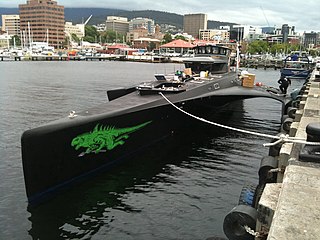
MV Brigitte Bardot is a high-tech 35 m (115 ft) stabilized monohull twin diesel engine powered vessel designed by Nigel Irens. Construction of the vessel began in June 1997 and she was launched on 16 March 1998. The official naming ceremony took place on 3 April 1998 in London's West India Dock. In 2021, the vessel was sold to a private owner.
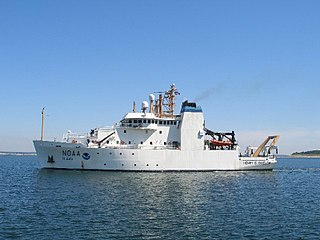
NOAAS Henry B. Bigelow is a fisheries research vessel operated by the United States' National Oceanic Atmospheric Administration (NOAA). She is the second in a class of five fisheries research vessels. She is named after Henry Bryant Bigelow (1879-1967), the American oceanographer, zoologist, and marine biologist who founded the Woods Hole Oceanographic Institution in Woods Hole, Massachusetts.
The motor yacht Titanic is a 1,900-tonne yacht that was formerly the Japanese Government's research/fishing vessel Toko Maru and later Kelso. In March 2010, she developed a leak while sailing in the Caribbean. Her rescue by the United States Coast Guard was co-ordinated from the United Kingdom.
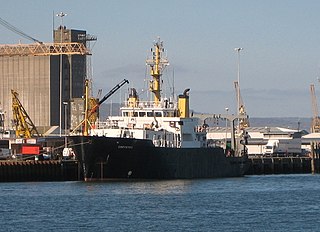
RV Corystes is an ocean-going, research vessel operating around Northern Ireland. She is equipped with specialist fishing gear and acoustic techniques for surveys of fish stocks.

Athena is a 7,805 GT factory ship which was built in 1992. In October 2010, she caught fire off the Isles of Scilly. In May 2011 she caught fire while lying at the harbour of Runavík in Skálafjørður, Faroe Islands. It happened at night, and people who lived on the other side of the fjord, where the smoke was headed, were evacuated. Some months later the ship was sold to Smedegaarden in Esbjerg, which took her apart.

NOAAS David Starr Jordan (R444)) was an American fisheries research vessel in commission in the National Oceanic and Atmospheric Administration (NOAA) from 1970 to 2010. She previously was in the United States Fish and Wildlife Service's Bureau of Commercial Fisheries fleet from 1966 to 1970 as US FWS David Starr Jordan.

RV Cirolana was a fisheries research vessel used by the Centre for Environment, Fisheries and Aquaculture Science and originally built for the Ministry of Agriculture, Fisheries and Food. She was initially intended to replace the RV Ernest Holt operating in arctic waters around Bear Island (Norway) and Iceland, but following the Cod Wars spent most of her working life conducting fisheries surveys in the North Sea, Irish Sea and English Channel. For the first part of her career RV Cirolana was based in the fishing port of Grimsby, but after bridge and channel dredging work improved the depth, it was deemed acceptable to bring her to Lowestoft.

RV Huxley was the first research vessel used by the Marine Biological Association of the United Kingdom explicitly for fisheries research and is regarded as the first vessel yielding data for the Ministry of Agriculture, Fisheries and Food - Directorate of Fisheries, now known as the Centre for Environment, Fisheries and Aquaculture Science (Cefas).
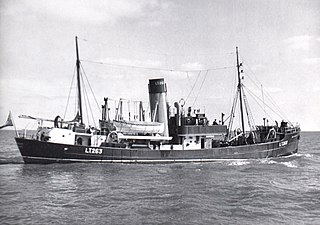
RV Sir Lancelot (LT263) was a fisheries research vessel that was operated by the Directorate of Fisheries, now known as the Centre for Environment, Fisheries and Aquaculture Science (Cefas).

RV Ernest Holt (GY591) was a fisheries research vessel that was operated by the Ministry of Agriculture, Fisheries and Food - Directorate of Fisheries, now known as the Centre for Environment, Fisheries and Aquaculture Science (Cefas).

RV George Bligh (LO309) was a fisheries research vessel that was operated by the Directorate of Fisheries, now known as the Centre for Environment, Fisheries and Aquaculture Science (Cefas).

RV Corella (LT767) was a fisheries research vessel that was operated by the Ministry of Agriculture, Fisheries and Food - Directorate of Fisheries, now known as the Centre for Environment, Fisheries and Aquaculture Science (Cefas) between 1967 and 1983.

RV Clione (LT421) was a fisheries research vessel that was operated by the Ministry of Agriculture, Fisheries and Food - Directorate of Fisheries, now known as the Centre for Environment, Fisheries and Aquaculture Science (Cefas) between 1961 and 1988.

RV Platessa (LT205) was a fisheries research vessel that was operated by the Ministry of Agriculture, Fisheries and Food - Directorate of Fisheries, now known as the Centre for Environment, Fisheries and Aquaculture Science (Cefas) between 1946 and 1967.

SS Joseph & Sarah Miles (LO175) was a ‘mission ship’, constructed for the Royal National Mission to Deep Sea Fishermen and operated from 1902 until 1930. She acted as a hospital ship during the Dogger Bank incident on the night of 21/22 October 1904, when the Russian Baltic Fleet mistook a British trawler fleet for the Imperial Japanese Navy and fired on them in the North Sea.
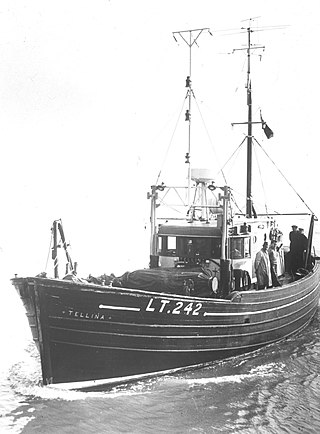
RV Tellina (LT242) was a fisheries research vessel that was operated by the Ministry of Agriculture, Fisheries and Food - Directorate of Fisheries, now known as the Centre for Environment, Fisheries and Aquaculture Science (Cefas) between 1960 and 1981.
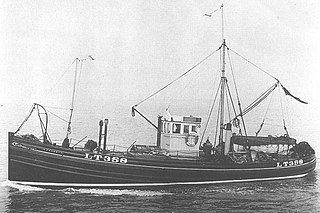
RV Onaway (LT358) was a fisheries research vessel that was operated by the Ministry of Agriculture, Fisheries and Food - Directorate of Fisheries, now known as the Centre for Environment, Fisheries and Aquaculture Science (Cefas) between 1930 and 1960. She was briefly requisitioned by the Admiralty, to serve as a Boom Defence Tender during World War II, but returned to Ministry service in 1946. In 1960 the RV Onaway was replaced by the RV Tellina.
The SY Hildegarde and the SY Hiawatha were steam yachts chartered by the Ministry of Agriculture, Fisheries and Food - Directorate of Fisheries, now known as the Centre for Environment, Fisheries and Aquaculture Science (Cefas) between 1912 and 1914 to carry out fishery investigations.


















